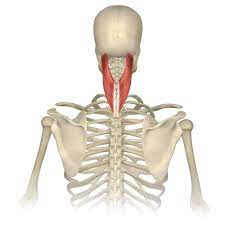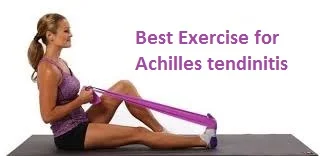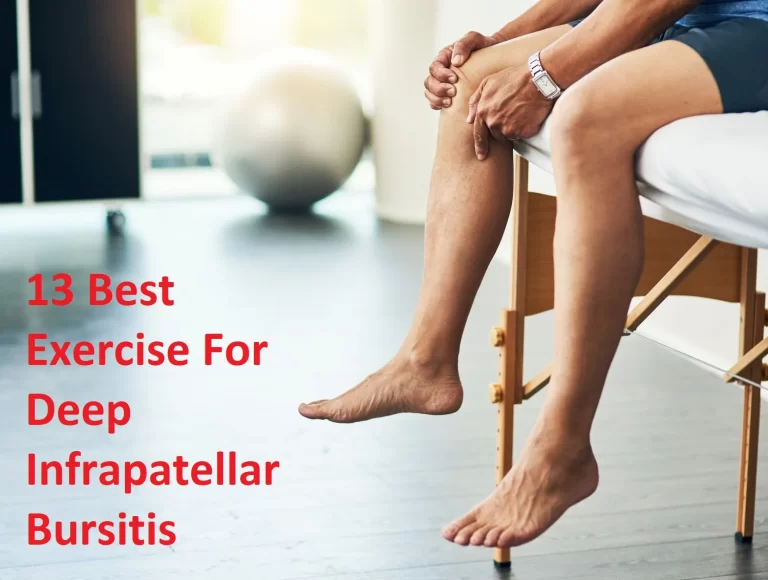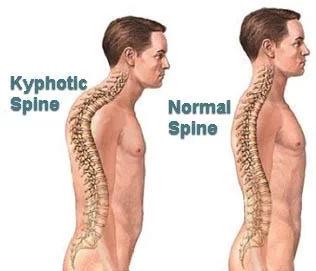Lunges
Table of Contents
Introduction
Lunges are a popular exercise that targets multiple muscles in your lower body, including your quadriceps, hamstrings, and glutes. They are functional movement that mimics everyday activities like walking, climbing stairs, and getting up from a seated position. Incorporating lunges into your workout routine can help improve lower body strength, stability, and balance.
Lunges can be performed in various ways to suit different fitness levels and goals. The basic lunge involves stepping forward with one leg, lowering your body down by bending both knees and then pushing back up to the starting position. This exercise primarily engages the front leg, while the back leg provides support.
lunges are very useful for avoiding any risk of injury, as well as used in rehabilitation programs after the occurrence of any injuries. It is frequently part of a foundational strengthing program or rehab program, with the help of this exercise sports persons or any exercisers get back to their sport or activity of interest as fast as possible.
Types of Lunges
There are several different types of lunges that can be performed to target different muscles and add variety to your workout routine. Here are some of the most common types of lunges:
- Forward Lunges: This is the most basic type of lunge and involves stepping forward with one leg and bending both knees to lower your body toward the ground. This exercise primarily targets the quadriceps but also works the glutes and hamstrings.
- Reverse Lunges: This type of lunge involves stepping backward with one leg and bending both knees to lower your body toward the ground. Reverse lunges primarily target the glutes and hamstrings but also work the quadriceps.
- Side Lunges: Side lunges involve stepping to the side with one leg and bending that knee to lower your body toward the ground. This exercise targets the inner and outer thighs, as well as the glutes and quadriceps.
- Walking Lunges: This exercise involves taking alternating steps forward with each leg and bending both knees to lower your body toward the ground. Walking lunges work all of the muscles targeted by forward lunges, but also require more balance and coordination.
- Curtsy Lunges: This type of lunge involves crossing one leg behind the other and bending both knees to lower your body toward the ground. Curtsy lunges primarily target the glutes and inner thighs.
- Jumping Lunges: Jumping lunges involve jumping from one lunge position to another, alternating legs with each jump. This exercise is a plyometric movement that targets all of the lower body muscles, as well as improving cardiovascular fitness.
- Bulgarian Split Squats: This exercise involves placing one foot on a bench or elevated surface behind you and bending the opposite knee to lower your body toward the ground. Bulgarian split squats primarily target the glutes, hamstrings, and quadriceps.
Overall, incorporating different types of lunges into your workout routine can help you target different muscles and prevent boredom. It’s important to use proper form and start with lighter weights or bodyweight before progressing to heavier weights or more challenging variations.
The lunges are also a functional exercise that makes you ready for movements necessary in daily life.
For example, it is a very common posture for people to assume to get up from the ground surface, and it copies many of the movements and muscle-activation forms of routine activities, just as walking and running and going ascending or descending stairs.
What Muscles Do Lunges Work?
Lunges are a compound exercise that primarily targets the lower body muscles, including the glutes, hamstrings, and quadriceps. However, other muscles are also involved in the movement to support and stabilize the body.
- Glutes: The gluteus maximus, medius, and minimus are the primary muscles worked during lunges. These muscles are responsible for hip extension, abduction, and external rotation, which are all involved in the lunge movement.
- Hamstrings: The hamstrings are a group of three muscles which is placed at the back of the thigh. They work in conjunction with the glutes to extend the hip and flex the knee during lunges.
- Quadriceps: The quadriceps are a group of four muscles which is placed at the front of the thigh. They work to extend the knee and straighten the leg during lunges.
- Calves: The calf muscles, including the gastrocnemius and soleus, work to stabilize the ankle joint during lunges.
- Core: The core muscles, including the abdominals and lower back muscles, work to stabilize the spine and pelvis during lunges.
Overall, lunges are an effective exercise for building strength and improving lower-body muscle endurance. By incorporating different variations and adding weights, you can continue to challenge your muscles and see progress in your fitness journey.
Lunges Exercise Video
How to perform?
To perform a basic forward lunge:
Standing with your feet hip-width aside and your hands on your hips or by your sides.
Take a step forward with one leg, keeping your knee directly over your ankle.
Lower your body towards the ground by bending both knees, keeping your back straight and your chest lifted.
Stop when your front thigh is parallel to the ground and your back knee is floating just over the floor.
Push through your front heel to get back to standing, and do it again on the other side.
To perform a reverse lunge:
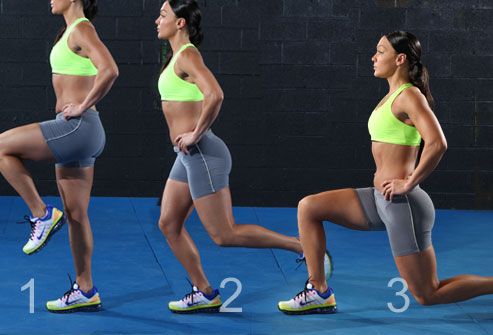
Standing with your feet hip-width aside and your hands on your hips or by your sides.
Take a step backward with one leg, keeping your knee directly over your ankle.
Lower your body towards the ground by bending both knees, keeping your back straight and your chest lifted.
Stop when your back knee is floating just over the floor.
Push through your front heel to get back to standing, and do it again on the other side.
To perform a side lunge:
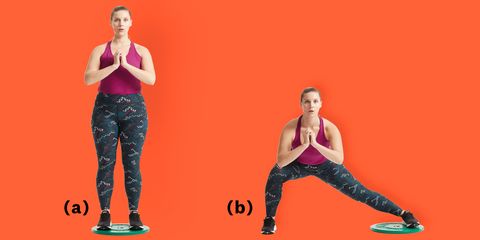
Standing with your feet wider than hip-width aside and your toes pointing forward.
Take a step to the side with one leg, keeping your knee directly over your ankle.
Lower your body towards the ground by bending the knee of the leg you stepped out with, keeping the other leg straight.
Stop when your thigh is parallel to the ground surface and your other leg is straight.
Push through the heel of the bent leg to get back to standing, and do it again on the other side.
To perform a walking lunge:
Standing with your feet hip-width aside and your hands on your hips or by your sides.
Take a step forward with one leg and lower your body towards the ground by bending both knees.
Stop when your front thigh is parallel to the ground and your back knee is floating just over the floor.
Push with your front heel to stand up and take another step forward with the other leg, do it again the lunge on that side.
Continue alternating legs as you walk forward.
To perform a curtsy lunge:
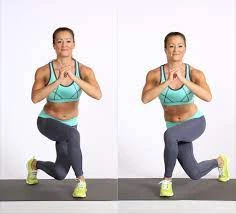
Standing with your feet hip-width aside and your hands on your hips or by your sides.
Cross one leg behind the other and bend both knees to lower your body toward the ground.
Stop when your back knee is hovering just above the floor.
Push with your front heel to get back to standing, and do it again on the other side.
To perform a jumping lunge:
Standing with your feet hip-width aside and your hands on your hips or by your sides.
Take a step forward with one leg and lower your body towards the ground by bending both knees.
Stop when your front thigh is parallel to the ground and your back knee is floating just over the floor.
Push with your front heel to jump up, switching legs in mid-air and landing in a lunge position on the other side.
Continue jumping and alternating legs for several repetitions.
To perform a Bulgarian split lunge:
Standing facing away from a bench or elevated surface, with one foot resting on it behind you.
Bend the knee of your front leg to lower your body towards the ground, keeping your back straight and your chest lifted.
Stop when your front thigh is parallel to the ground and your back knee is floating just over the floor.
Push with your front heel to return to standing, and do it again on the other side.
Benefits of Lunges
Lunges are a popular exercise that can provide numerous benefits for your body. Here are some of the key benefits of lunges:
Strengthens leg muscles: Lunges target the muscles in your legs, including your quadriceps, hamstrings, glutes, and calves. By regularly performing lunges, you can build strength in these muscles and improve your overall lower body strength.
Improves balance and stability: Lunges require you to maintain your balance and stability, which can help improve your overall coordination and proprioception (your body’s awareness of its position in space).
Enhances core strength: Lunges engage your core muscles as you stabilize your body during the exercise. This is helpful in improving your overall core endurance and stability.
Increases flexibility: Lunges require you to move through a full range of motion, which can help increase your overall flexibility and mobility.
Boosts cardiovascular endurance: Lunges can be performed as high-intensity exercises, such as jumping lunges or walking lunges. These variations can help increase your heart rate and improve your cardiovascular endurance.
Improves posture: Lunges require you to maintain proper form and alignment, which can help improve your overall posture and reduce the risk of injury.
Burns calories: Lunges are a compound exercise that targets multiple muscle groups at once. This can help increase your calorie burn and contribute to weight loss or weight maintenance.
Overall, lunges are a versatile exercise that can provide numerous benefits for your body. Whether you’re looking to build strength, improve balance and stability, or increase flexibility, lunges are an effective exercise to include in your workout routine.
Precautions
While lunges are generally a safe exercise, there are some precautions you should take to avoid injury:
Start slowly: If you’re new to lunges, start with a few repetitions and gradually increase the number over time. This will help your muscles adapt to the exercise and reduce the risk of injury.
Maintain proper form: When performing lunges, make sure to keep your back straight, your shoulders relaxed, and your knees aligned with your toes. Avoid leaning forward or twisting your body, as this can put unnecessary strain on your joints.
Use proper footwear: Make sure to wear supportive shoes that provide good traction and stability. This will be useful in preventing slips and falls during the exercise.
Warm up properly: Before performing lunges, make sure to warm up your muscles with some light cardio or dynamic stretching. This is useful in preparing your body for exercise and reducing the risk of injury.
Avoid overexertion: Don’t push yourself too hard when performing lunges, especially if you’re feeling fatigued or experiencing pain. Stop the exercise if you feel any discomfort or pain, and consult a healthcare professional if necessary.
By following these precautions, you can safely enjoy the benefits of lunges without putting yourself at risk for injury.
FAQ
The depth of the lunge depends on your mobility and strength. Ideally, you should aim to lunge until your front thigh is parallel to the ground or lower. However, if you have any mobility issues or injuries, you may need to modify the depth of your lunge.
Lunges can hurt your knees if they are not performed correctly or if you have pre-existing knee injuries. To prevent knee pain, make sure to maintain proper form and alignment during the exercise, and start with lighter weights or bodyweight lunges.
The frequency of lunges depends on your fitness goals and training program. Generally, it is recommended to perform lunges 2-3 times per week for strength and muscle building.
To improve your lunge form, focus on maintaining proper alignment of your feet, knees, hips, and spine. Practice with lighter weights or bodyweight lunges before adding resistance. You can also take proper guidance from a certified personal trainer or coach.


